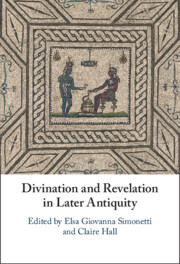Book contents
- Divination and Revelation in Later Antiquity
- Divination and Revelation in Later Antiquity
- Copyright page
- Contents
- Illustrations
- Notes on Contributors
- Acknowledgements
- Introduction
- Part I Philosophical Perspectives on Divination, Revelation, and Prophecy
- Part II Status, Role, and Functions of Human Intermediaries
- Chapter 5 ‘The Holiest Man Ever Born’: Sages, Theioi Andres, and the Shaping of Late Greek Prophecy
- Chapter 6 Women and Divine Dreams in Jewish Texts of the Greco-Roman Era
- Chapter 7 Epiphany and Divination Reconsidered
- Chapter 8 The True Prophet in the Pseudo-Clementine Homilies
- Part III Divine Transcendence and Pragmatic Purposes
- Index
- References
Chapter 7 - Epiphany and Divination Reconsidered
The Case Study of the Iamata from Imperial Pergamum
from Part II - Status, Role, and Functions of Human Intermediaries
Published online by Cambridge University Press: 19 October 2023
- Divination and Revelation in Later Antiquity
- Divination and Revelation in Later Antiquity
- Copyright page
- Contents
- Illustrations
- Notes on Contributors
- Acknowledgements
- Introduction
- Part I Philosophical Perspectives on Divination, Revelation, and Prophecy
- Part II Status, Role, and Functions of Human Intermediaries
- Chapter 5 ‘The Holiest Man Ever Born’: Sages, Theioi Andres, and the Shaping of Late Greek Prophecy
- Chapter 6 Women and Divine Dreams in Jewish Texts of the Greco-Roman Era
- Chapter 7 Epiphany and Divination Reconsidered
- Chapter 8 The True Prophet in the Pseudo-Clementine Homilies
- Part III Divine Transcendence and Pragmatic Purposes
- Index
- References
Summary
In a recent article in the journal Kernos (2018, 31: 39–58), Julia Kindt compared ancient Greek epiphanic and oracular narratives and rightly argued that although both epiphany and divination explore analogous issues of limited human cognition at the face of the divine, recent studies of divine epiphany (Verity Platt, Facing the Gods: Epiphany and Representation in Graeco-Roman Art, Literature and Religion, Cambridge University Press 2011, and Georgia Petridou, Divine Epiphany in Greek Literature and Culture, Oxford University Press 2015) tend to keep discussions of these religious phenomena separate. This chapter is an attempt to readdress this seeming imbalance by focusing more explicitly on complex self-conscious narratives pertaining to incubation (enkoimesis, kataklisis) in Imperial Pergamum, a religious practice that could be thought as offering an interesting intersection of divine epiphany and what Kindt calls ‘inspired divination’. More specifically, this paper focuses on the dynamics and problematics of diagnostic and therapeutic divination, as delineated in Aelius Aristides’ Sacred Discourses (Hieroi Logoi, Or. 47–52 Keil), Galen’s De curandi ratione per venae sectionem (4.23 = 11.314–315 K.), and contemporary epigraphic evidence from the temples of Asclepius in Pergamum and Epidaurus.
Keywords
- Type
- Chapter
- Information
- Divination and Revelation in Later Antiquity , pp. 136 - 158Publisher: Cambridge University PressPrint publication year: 2023

